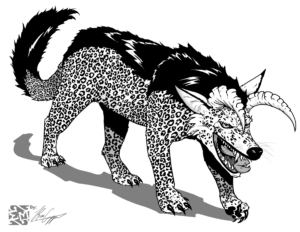
Theracapricanis
Illustration by Epic Made
Trespassing in a Cassius village was extremely dangerous for any creature—human or otherwise. Most of the genetically engineered animal hybrids were designed to be very violent and would attack anyone or anything within reach. The risks became quite evident one night.
H’Ilgraith, as a gray fox, crept closer to the Cassius village. Suddenly, she heard the sound of another animal. Alerted, she stopped abruptly and made no further sound. A shifting breeze carried the scent of a hybrid animal.
H’Ilgraith knew she was in grave danger. She bolted toward the trees. Fortunately, the genes of a great horned owl gave her a critical advantage. The more powerful hybrid was gaining on her, certain of a fresh meal, when it flushed an owl from the brush.
(Excerpt from H’Ilgraith.)
“The profound flow of action alternating with science will keep the reader engaged and inspired.” Rev. Dr. Jerrold L. Foltz
Animal Hybrids
In animal-animal hybrids, the base genome belonged to one animal with other animal genes added. Native mammals did not have the capability to undergo metamorphosis into other species. Consequently, the Cassius Foundation altered animal genomes were by inserting the genes of other species into a fertilized egg or a developing embryo. The foundation’s geneticists would attempt to isolate the specific genes for the features that would enhance the animal’s killing power. Using their customary method of trial and error genetic engineering, they would splice different gene sequences into several fertilized eggs until they attained the desired result.
The base genome of the theracapricanis [thĕr-ah-căp-rah-căn-ĭs] was the leopard. The leopard’s genome was augmented with the genes of a jackal (‒canis) and an ibex (‒capra) to create an enhanced animal hybrid that would prey on any species, including humans. It possessed the power and bite force of the leopard, the horns of the ibex, and the stamina of the jackal.